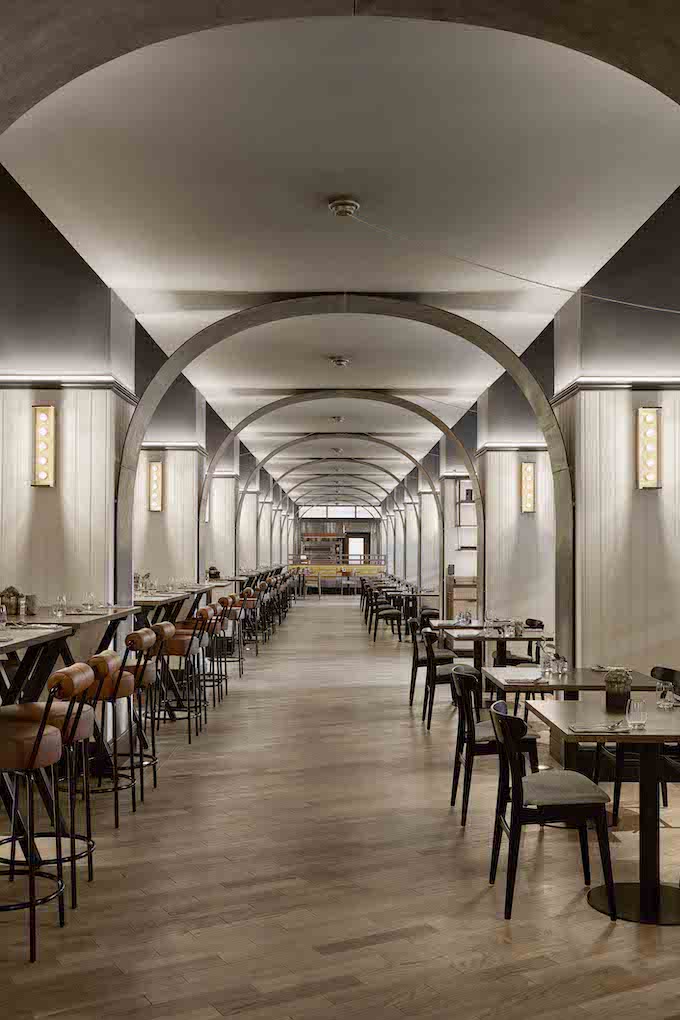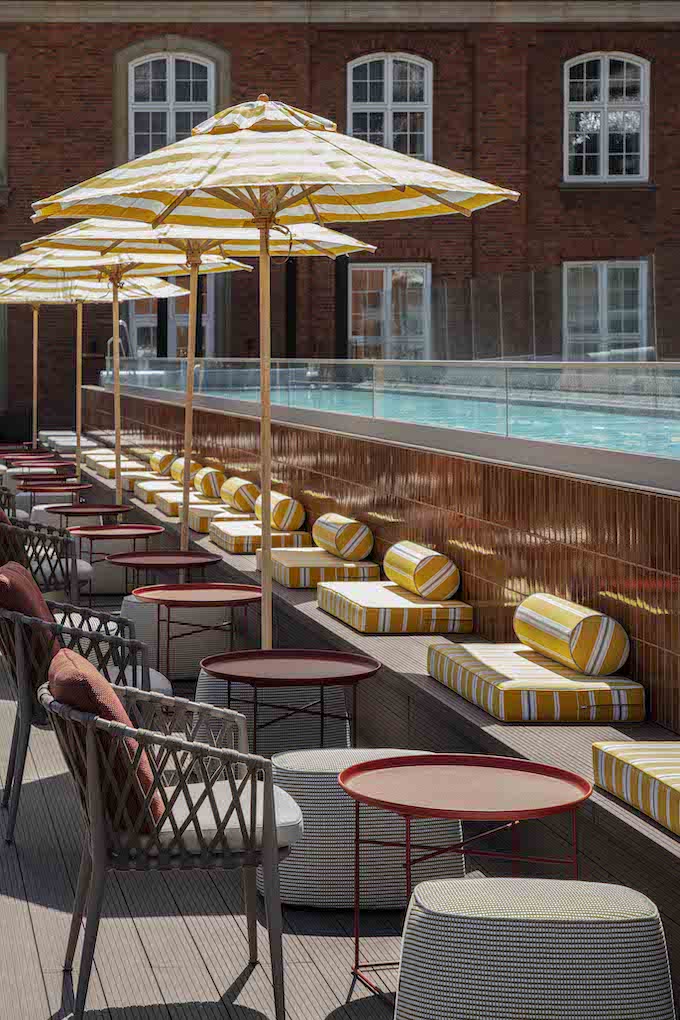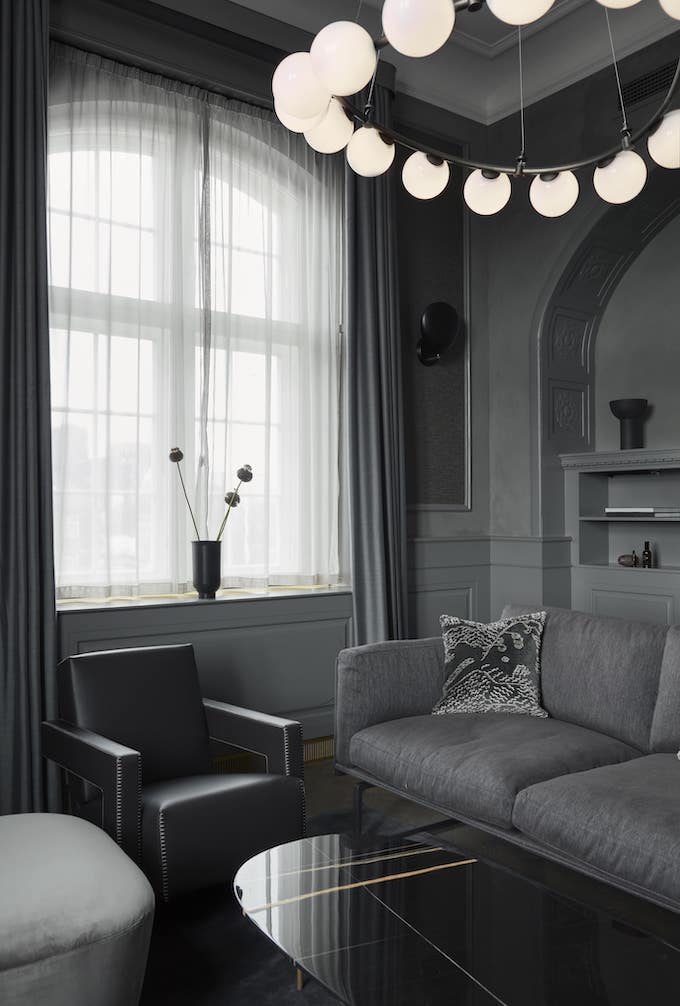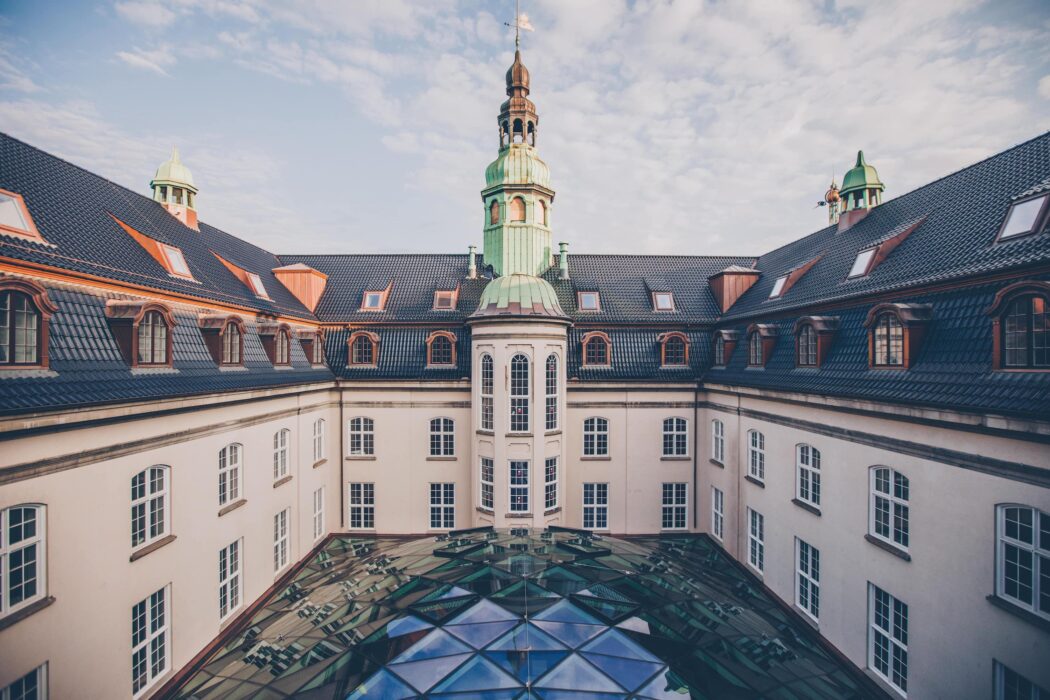What is beauty? Something that pleases the eye, something we call attractive? Your beauty will most likely be different from my beauty or at least how you perceive it. Whether a building can be classified as beautiful or not lies within each of our hands. A building or a design within it is only the creative expression from that person who was appointed to alchemise a thought into a physical entity. A building that does this well is Villa Copenhagen standing magnificently tall and wide in Copenhagen, Denmark. The city’s most eagerly awaited hotel, originally designed in 1912 by Architect Heinrich Wench, has recently launched in July, after an extensive internal renovation. Peter Høgh Pedersen, managing director of Villa Copenhagen highlights, “This project has proven to be a labour of love. The vision behind the build was to create an authentic destination – for the many and not the few.”
Villa Copenhagen is an architectural landmark located adjacent to the famed Tivoli Gardens and Copenhagen’s train station. The existing building is designed in Neo-Baroque style which displays important aspects of the Baroque architectural traditions. This style is famous for contrast, exuberant detail, grandeur and surprise to achieve a sense of awe. As a transformative process, Interior Architecture pays respect to that rich tapestry of creation and culture. Specifically, this new hotel starts a dialogue between old and new, within the building itself and around it, forming a new district that is regenerating for the city. The hotel compromises of 381 guest rooms, as well as nine exclusive suites all individually designed, 5 restaurants and bars, meeting and event spaces, fitness and wellness facilities adjacent to a rooftop pool with cabana service. There are outdoor and interior “green spaces” promoting wellbeing and tranquillity which amplifies the magnitude of Villa Copenhagen being like a jewel to attract in tourists, business entrepreneurs and the local city dwellers too.
With Interior Architecture, there is a clear starting point: the existing building. Either a building has to be preserved due to regulations or the building is too beautiful not to reform it. Just look around the central streets of Belgravia & Mayfair in London for example. The new hotel is situated in the Danish capital’s former Central Post & Telegraph Head Office, and the new design draws notably on the buildings former use. From a design perspective guests can “expect a contemporary and classic Scandinavian design that accentuates the original architecture in both the communal spaces, room and suite interiors to create an inspiring and playful ambience.”
Why does one choose to open up their design career by studying Interior Architecture? Perhaps to avoid the seven years of minimum study to become an Architect, or even because there is an innate beauty in existing buildings. I’ve always loved buildings, from a very early age. I’ve been gifted with an eye that can quickly identify good taste, well-proportioned and high-quality workmanship within architecture and the components that make up a building. I want to saviour these stunning features that are now becoming rare.

Today, we want to be more sustainable, more mindful of how we use our planet and most of us have a desire to reduce waste or reuse what we already have. This is why I am an advocate for Interior Architecture. The beauty of Interior Architecture as a design discipline also lies within its mystery. Interior Architecture sits in between famous Architecture and sometimes gets muddled into the umbrella discipline of Interior Design. But essentially Interior Architecture is a discipline that bridges the gap between architecture and interior decorative design yet encompasses both of those elements into its entirety too. Interior Architecture is Interior Design within existing buildings.
Interior Architecture is the process of sensitively analysing an existing building, with a clear outcome to improve the flow, circulation and efficiency of the building which makes it fit for its new purpose. By drawing on the natural context and microclimate around a building, designers can positively improve the functionality for the user and as a knock-on effect improve the overall experience too. Universal Design Studio were appointed to design the 381 room suites as well as The Penthouse Suite at Villa Copenhagen. Richard McConkey, Associate Director, recognised that “Copenhagen has a beautiful quality of light, which, alongside the feeling of quiet beauty in the artwork of Hammershøi, became a key reference point in our design process.” The rooms are clearly influenced by Scandinavian design featuring a balance of materials that are calming, fresh and everlasting. Simple design tricks in the room, include a feature a wall-length tinted mirror with a textured glass façade that invites natural daylight into the bathrooms while reflecting views from the refurbished period windows, enhance the natural light and beauty of the building’s heritage.
Filtering through the historical features and characteristics becomes a vital part of the regeneration process to add value and interest to a new design. This is something Universal have honed in on to inform the contemporary design for the rooms which consist of warm, muted colour palettes using soft ochre, brick and copper tones. The original building of Villa Copenhagen comprises of five storeys with a range in ceiling heights, so every single guest room is different. Universal began the design process by “mapping” the interiors of the building and made the decision to either reinstall or restore original period features. Each room varies due to the differing Interior Architecture – and therein lies the beauty of the design discipline. The rooms all have to naturally take on their existing surroundings providing unique experiences for guests. The rooms on the lower floors have dramatic 4-metre ceilings respecting the floor to ceiling windows, whereas the rooms in the upper floors are housed in the converted attic meaning the exposed timber beams accentuate charm and cosiness for guests. Rather than being a hindrance within the design process, constraints and parameters of a building are used as a driving force to impact the design strategy.
Also part of Universal’s remit, are the original grand staircases, waiting areas and hallways throughout the hotel which have been restored back to their original quality to link hotel users to the communal areas.

Epicurean, the sister company to design house Goddard & Littlefair, were responsible for designing the restaurants, bars, wellness and pool and various meeting event spaces. In contrast to the calm bedroom suites, the communal spaces of the hotel are eclectic, rich in deep colour and material, with a quirky play on texture. Drawing on inspiration from the Neo-Baroque existing architecture and accentuating that influence, means each area of cuisine offers an immersive experience with unexpected surprises. Check the bar in T37 Bar with hanging satchel straps made from former post bags! Epicurean’s design ethos is to experience sensual enjoyment, which is captured across the 5 dynamic restaurants and bars within the hotel.
In design – form always follows function, but initial creative stages are fun because the history of the building is implemented into the design strategy and usually influences initial concepts. With the external parameters of the walls set in place, you are working with an existing volume to maximise the potential of a space, you have the beauty of the architecture around you to create an interior that fits in with the worlds ever-changing modernity. The copper archways strategically placed in Public and Rug Bakery are an immediate striking insertion seen in the Danish bakery. Here we see the modern design influenced by the building being a former sorting office and the copper has been taken from the hotel rooftop. Referencing original archways, lights with draped flex, reeded wall panelling and original glazed brickwork, when in the space, you are embodying the experience of being in the revitalised sorting room. A space that used to sit alongside the railway tracks where the post was historically distributed by train. These are extremely subtle insertions into the existing building. So subtle, that the user may not even notice, but it influences the experience overall. The intricacy between old and new is always expressed with respect, using specific materials that allow the intersect to breathe. The Pool Bar is inspired by the shapes cast from old panelling, and similar to the bakery, copper from the roof has been used to form the bar front. The yellow tiles referencing the sorting room have been used to create a cohesive design language throughout. What is lovely is each layer of time from the building’s history is woven together intricately allowing each aspect of the design to express its individual beauty.
With technology and ideas ever-changing, the industry also continues to expand and grow to reflect this. Villa Copenhagen is a large building so unavoidably the design team consisted of different designers due to the scale of the building, but also because each designer brings a diverse quality to different areas. This can be seen in the very distinctive design expressions of the hotel’s executive suites. Eva Harmou has designed the Earth Suite which is feminine, selective and sedative. Every single material and textile specified is recycled and all furniture is eco-friendly making this very pink, cool, serene suite fully sustainable. The seven remaining suites designed by Shamballa Jewels are in contrast, dark, moody and a sophisticated sense of home. Existing features have been designed around, with contemporary panelling used to enhance the volume of space but also create intimacy.

There is a continual flow of change throughout this hotel that is intriguing and exciting – not overbearing. Each designer brings their interpretations and creative thought into the design process developing an abundance of changing spaces. It is through the clever teachings of blending old and new where the constraints of an existing building provoke beauty. The original building initiates and provides the direction to influence the brief. Whilst I love the variation of design throughout the building and it always thrills me to see the heritage meticulously restored and revitalised, my favourite aspect is the 25 metre lap pool, simply because it is heated by the excess heat from the hotel’s cooling system. There is nothing more beautiful than being energy efficient to respect nature.
The beauty of internal remodelling is that when you discover the discipline, it opens up a whole new dimension of possibility to be creative in a different way. It is a blending of working with existing volumes, proportions, character, paying homage to history where relevant and drawing on the context around the building to design a space that functions for the benefit of its new use. The art and science of Interior Architecture are so quietly clever it doesn’t disturb your experience, it enhances it. Villa Copenhagen is a fine example of how history is brought forwards to reinvigorate a building to enable community and business regeneration. It is within the design process and the inevitable end outcome, that beauty is unravelled yet created. As a result of carefully considered design and renovation, the spaces look beautiful but also provide a sense of beauty through the new experience. Spaces should be there to allow you to feel. To feel excited, to feel charmed, to feel welcomed. At the heart of Villa Copenhagen’s hotel experience, they promote conscious luxury, conscious dining, conscious retreat, happiness and contrast. These attributes would not be possible without the thought, devotion of idea and energy from the different architectural designers appointed to regenerate this extraordinary building. To top it off, with a private art collection valued at over 2 million US$, this is a place not to be missed.
I believe we need more Interior Architects and we need more people to be aware of Interior Architecture. This specific design process should be sung about from the rooftops of these heritage buildings. We should be creating to regenerate, allowing explorative and captivating experiences, for both designer and dweller. I’m passionate about playing with what is already in existence. Interior Architecture is less ephemeral than interior décor, it stands a longer test of time and more of us should want to save all forms of architecture and pull it into the next modern era. Interior Architecture is a discipline that generates and sustains beauty by preserving more of what we have. In the famous words of Keats:
“Beauty is truth, truth beauty,—that is all
Ye know on earth, and all ye need to know.”
Beauty is what we make of it. We can make more of it, through this beautiful discipline.


